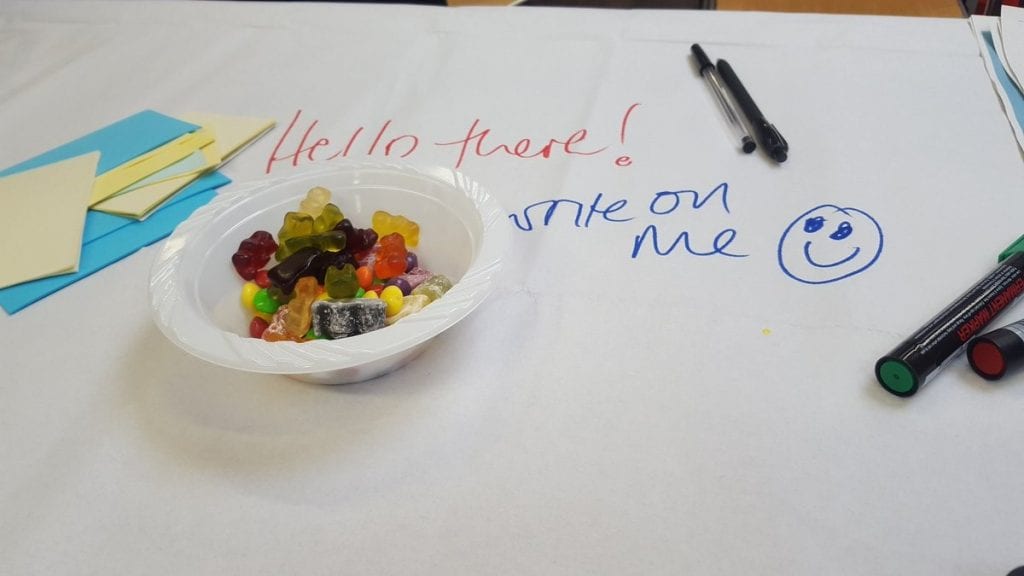Creative Evaluation: Public Engagement Network Meeting
By Briony Fleming, on 29 October 2018
This post has been written by Helen Craig: Public Engagement Manager (SLMS)
Does evaluation for impact always have to mean a questionnaire? The latest Public Engagement Network meeting was all about Creative Methods for Evaluating Impact, so that’s the question 20 UCL researchers came together to explore on Wednesday October 10 2018. Dr. Gemma Moore and Lizzie Cain from the Evaluation team in UCL Culture teamed up to give an overview of their work and introduce us to the “so what” test: an effective method for getting to the difference you hope to make with your activities. They emphasised that public engagement can be a pathway to any type of impact – from health and wellbeing, to economic and commercial – and that evaluation is only useful as long as it’s useful to you. We then heard from two guests who had experience in creatively evaluating their events.
Dr. Helen Stark, Research Impact Manager at UCL, gave a peek behind the curtain for how she evaluated an evening event looking into people’s emotional experiences with objects. The evaluation was run through the event like a watermark with each stall featuring a chance to leave feedback, often in the form of participatory art, and a final evaluation stand that was designed like a huge game of mousetrap.
Anne Crisp spoke next, sharing her personal experiences with creatively evaluating events and a checklist of over 30 possible methods of doing so. Anne works in Community Development at Aston-Mansfield, a Charity based in the London Borough of Newham which delivers a range of services for children, young people and families in east London. Over her career Anne has arranged everything from walk and talk sessions with young adults, to gathering feedback on paper tablecloths from family groups. Attendees then had the chance to put what they’d learnt into practice with small group sessions facilitated by the engagement team, creating sample evaluation plans and discussing past projects.
If you were unable to attend you can still download the resources:
Public Engagement Network Meeting slides
Example Evaluation Worksheet
Aston-Mansfield Creative Evaluation
The engagement team have produced a number of resources to help with evaluation which can be found on our website. See below our top tips for evaluation.
10 top tips for evaluating your engagement project
- Don’t leave evaluation to the end of a project or activity, build evaluation in at the start. We believe evaluation is an on-going, iterative process that takes places throughout the life of a project or activity.
- Evaluation should link to the aims and objectives of your project. Take time to define what these are, and think carefully about what changes you think your project may have.
- Think about what to measure before how to measure! Assess and measure what is important rather than what is easy to measure.
- Another questionnaire??? There are lots of evaluation methods, both quantitative and qualitative methods, think about what method is appropriate.

- Evaluation should not (just be) about showcasing successes. The unexpected, unpredicted, and experiences of failure and confusion are all part of the evaluation process.
- Evaluation can enable a range of people’s voices to be heard; a diversity of stakeholders and perspectives should be involved in the evaluation process.
- Evaluation should lead to action – use your evaluations to make decisions, plan activities, develop resources and advise others.
- Consult and collaborate with colleagues and communities to ensure you’re your evaluation approach constantly evolves.
- Don’t produce a report that sits on a shelf: share the learning from your evaluation in a number of ways (toolkits, advice, case studies, presentations and reports).
- Ask for help
We love to hear your opinions on what would help and so if you have any ideas please drop us a line: publicengagement@ucl.ac.uk.
 Close
Close


